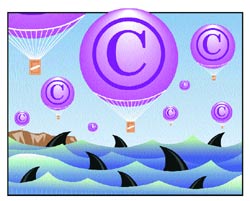]> Statutes and contract provisions are the first line of defense against intellectual property infringement. Your intellectual property may be your most valuable
April 6, 2018

]>
Statutes and contract provisions are the first line of defense against intellectual property infringement.


Your intellectual property may be your most valuable asset, particularly if you are a video game developer or publisher. Yet even though licensors often spend significant sums developing or acquiring intellectual property assets, some or all of an IP asset's value may be lost due to the failure to take certain basic steps. Here, a look at different types of intellectual property and the governmental filings and contract provisions available to protect and enhance the value of your IP.
Copyright Protection
The term "intellectual property" can encompass a variety of different types of assets, among them artwork, business models, trademarks, and databases. The United States Copyright Act (found starting at Title 17, Section 101 of the United States Code) is not intended to provide protection for each such type of asset. Rather, it extends protection to "original works of authorship fixed in any tangible medium of expression...from which they can be perceived, reproduced, or otherwise communicated, either directly or with the aid of a machine or device." Examples of such works include artwork, books, video games, films (since they can be seen through the use of a device), sound recordings, musical works, and architectural works. As for the other types of assets, a licensor typically would look to the trademark statutes to protect its trademarks, and to its contracts to protect trade secrets, such as business models and databases.
To better understand the scope of the Copyright Act, consider a licensor that has created a famous video game, such as "Super Mario Bros." The creator could seek copyright protection for any artwork used on the game box or in the game itself, as well as its characters. While the Copyright Act requires that the copyright owner file an application to obtain the benefit of certain remedies it provides, no filing is necessary to claim ownership in a copyright. Rather, the creator of a work automatically owns the copyright upon the work's creation.
However, the failure to file a copyright application can have serious implications. For instance, Section 106 of the Copyright Act grants the owner of a copyright the exclusive right to reproduce and distribute the copyrighted work. If a copyright holder can prove to a court that another party willfully infringed the copyright, the holder could recover up to $150,000 in statutory damages, regardless of the actual damages, and also could recover attorneys' fees, which can be substantial. However, generally a copyright holder cannot sue for infringement under the Copyright Act until the copyright has been registered with the Copyright Office. Also, if the infringement occurs before the application actually is filed, the copyright owner cannot seek the statutory damages or attorneys' fees. The possibility of having to pay legal fees can be a significant deterrent to someone who is infringing a copyright. Thus, the failure to file a copyright application can seriously hamper your ability to defend your copyright.
The filing of a copyright is fairly simple and inexpensive. The Copyright Office charges $30 for each application, and one application can cover a collection of works (such as multiple photographs or designs). Given the ease of filing an application, and the downside of failing to file, it's best to file the application as early as possible, even if you know there may be later design changes, for which you can file further applications.
Of course, the ability to file a copyright application assumes you are the owner of the copyright. If an employee creates a design for his or her employer, the employer will own the copyright automatically. However, if you hire and pay a consultant (as opposed to an employee) to create artwork, you will not own the copyright unless it is specifically assigned to you in writing by the consultant. Thus, if a non-employee is to create any materials for you, make sure you enter into a written agreement providing for the assignment of the copyright in the materials.
Trademark Protection
Trademarks and service marks are used to identify goods or services as being provided by a particular party. For instance, "Marvel" and "DC" are associated with particular lines of comic books. The Lanham Act (as the federal trademark statute is known) is found starting at Title 17, Section 1051 of the United States Code, and grants to trademark registrants the exclusive right to use a registered trademark for the goods or services specified in the trademark application. As with a copyright, the filing of a trademark application is a prerequisite to claiming infringement under the Lanham Act. Also, as is the case with copyrights, registration is necessary to obtain statutory damages and legal fees.
Unfortunately, filing an application under the Lanham Act is not as simple or inexpensive a process as under the Copyright Act. The filing fee is $325 per application. Further, there are 42 different categories into which a trademark use can fall (for instance, clothing falls into one category, and books another), and a separate filing fee must be paid for each category. Moreover, the trademark office carefully reviews each application to ensure the application meets the Lanham Act's requirements. For instance, a toy manufacturer likely would not be allowed to register the name "Fun Toys" as it is too descriptive of the product. As a result, the application process can take from one to two years. Nonetheless, filing an application is a prerequisite to protecting the value of a mark.
Contractual Protection
If a licensor hires a consultant, the consultant (and to be safe, each employee) should execute an agreement assigning to the licensor the title, including all copyrights, to any materials the consultant creates. Further, any such agreement should at a minimum contain the following provisions:
1. The employee/consultant should agree to keep all information regarding the licensor strictly confidential, and if requested by the licensor, furnish to the licensor all materials regarding the licensor's business that the employee/consultant may possess or later possess. In conjunction with this, a licensor should label all confidential materials as such, and put in place a written policy that details what additional steps consultants and employees should take to safeguard confidential information. By doing so, the licensor helps to ensure that information such as databases and other customer-related information (which generally are not protected by the Copyright Act) will be respected as trade secrets, which cannot be used by the consultant or employee after he or she leaves to work for another company.
2. If an employee or consultant were to improperly use confidential information, typically a court simply would provide a monetary award to the licensor to compensate it for damages suffered. Unfortunately, when it comes to confidential information, it can be difficult to determine what the damages may be. Further, the licensor will more likely be interested in keeping the information confidential than collecting damages. Thus, each agreement should specifically grant the licensor the right to obtain injunctive relief, such as the right to require the employee to refrain from using the information.
3. To ease the burden of bringing a lawsuit to enforce the license agreement, and to provide the licensor with meaningful leverage in a dispute, each agreement should provide that the licensor will be entitled to reimbursement of its legal fees and costs in enforcing the agreement.
Agreements With Licensees
In addition to the basic provisions you would expect to find in any license agreement (such as the duration of the license, whether or not it is exclusive, and what royalties are to be paid), the following are provisions that are not always included, but should be considered for any agreement:
Suppose you are licensing one of your trademarked video game characters for use by the licensee on its line of children's wear, and another manufacturer improperly uses the character on its line of clothing. Ideally, your license agreement would grant you the option of either bringing an action against the infringing party, or requiring your licensee to bring such an action (in which case, the licensee likely would want to keep some portion of any damages awarded). This has the effect of creating your own police force, at no cost, as far as protecting your IP.
Require your licensee to keep you informed of any third-party infringement of your IP rights of which it becomes aware.
Suppose you have licensed your trademark, "McKiddies," to someone, and a third party claims the trademark infringes its rights (i.e., "McKiddies" cannot be used to market a model restaurant manufactured by your licensee). In contemplation of this possibility, your license agreement should grant you the right to terminate the agreement if you determine such a claim has merit. Better yet, the agreement should grant you the option to terminate the license on a country-by-country basis to avoid the infringement claim. Thus, if you have granted a worldwide license, and another party in Thailand claims infringement, you simply could revoke the license with respect to Thailand without losing the benefit of the entire agreement.
If your licensee creates new characters that are related to your licensed character, make sure you address who owns the newly created property. For instance, suppose you have licensed the right to certain cartoon characters for use in a video game. If the licensee creates new characters for the game, the new characters will become associated with your characters, and you may want the ownership rights to such new characters. This type of provision is often the subject of much negotiation, and should be reviewed carefully with your attorney.
Creating and maintaining the value of your intellectual property is not simply a matter of creative design and finding the right licensee. Like any other asset, it must be protected. While tools such as statutes and contract provisions are available to provide such protection, careful thought must be given to using them effectively.
You May Also Like






